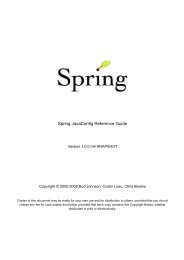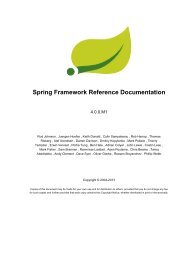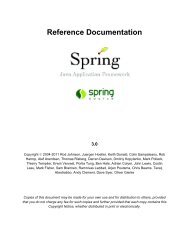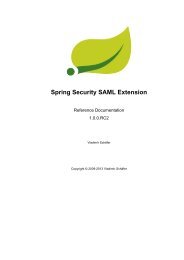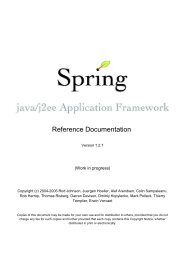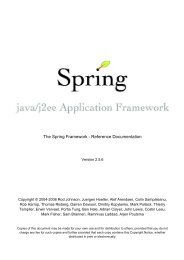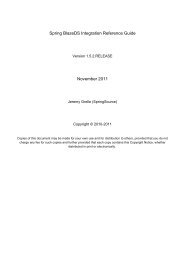Spring Data MongoDB - Spring Web Services - Parent - SpringSource
Spring Data MongoDB - Spring Web Services - Parent - SpringSource
Spring Data MongoDB - Spring Web Services - Parent - SpringSource
You also want an ePaper? Increase the reach of your titles
YUMPU automatically turns print PDFs into web optimized ePapers that Google loves.
please define productname in your docbook file!The first method allows you to pass an org.springframework.data.domain.Pageable instanceto the query method to dynamically add paging to your statically defined query. Sorting optionsare handled through the Pageable instance too. If you only need sorting, simply add anorg.springframework.data.domain.Sort parameter to your method. As you also can see,simply returning a List is possible as well. In this case the additional metadata required to build theactual Page instance will not be created (which in turn means that the additional count query that wouldhave been necessary not being issued) but rather simply restricts the query to look up only the givenrange of entities.NoteTo find out how many pages you get for a query entirely you have to trigger an additional countquery. By default this query will be derived from the query you actually trigger.Creating repository instancesIn this section you create instances and bean definitions for the repository interfaces defined. The easiestway to do so is by using the <strong>Spring</strong> namespace that is shipped with each <strong>Spring</strong> <strong>Data</strong> module thatsupports the repository mechanism.XML configurationEach <strong>Spring</strong> <strong>Data</strong> module includes a repositories element that allows you to simply define a basepackage that <strong>Spring</strong> scans for you.In the preceding example, <strong>Spring</strong> is instructed to scan com.acme.repositories and all its subpackagesfor interfaces extending Repository or one of its subinterfaces. For each interface found, theinfrastructure registers the persistence technology-specific FactoryBean to create the appropriateproxies that handle invocations of the query methods. Each bean is registered under a bean name thatis derived from the interface name, so an interface of UserRepository would be registered underuserRepository. The base-package attribute allows wildcards, so that you can have a pattern ofscanned packages.Using filtersBy default the infrastructure picks up every interface extending the persistence technology-specificRepository subinterface located under the configured base package and creates a bean instancefor it. However, you might want more fine-grained control over which interfaces bean instances getcreated for. To do this you use and elementsinside . The semantics are exactly equivalent to the elements in <strong>Spring</strong>'s contextnamespace. For details, see <strong>Spring</strong> reference documentation on these elements.1.4.0.BUILD-SNAPSHOT<strong>Spring</strong> <strong>Data</strong> <strong>MongoDB</strong> -Reference Documentation 10




